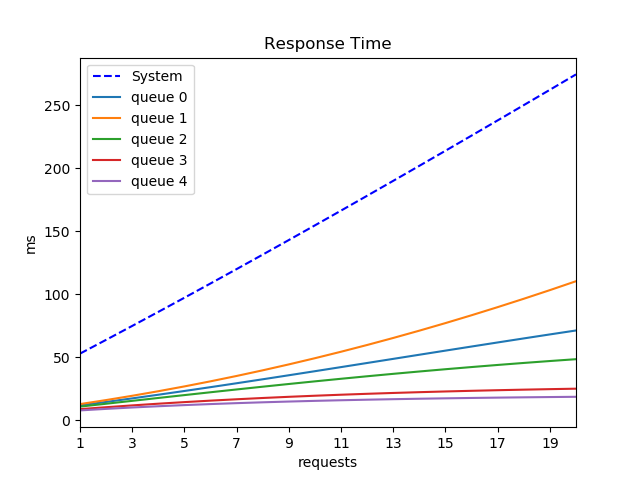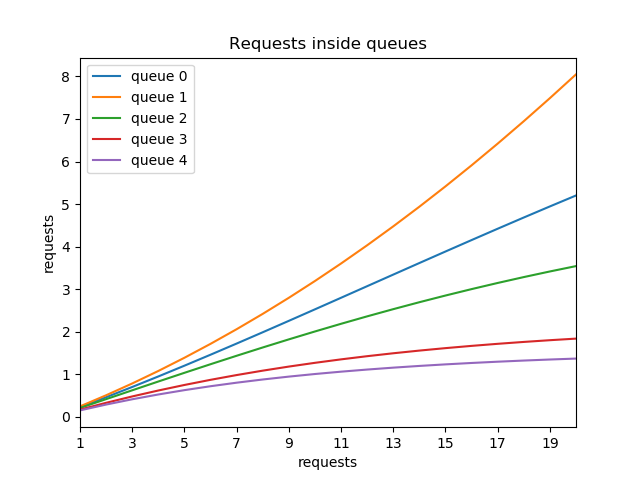These are a couple of small scripts for students attending "Capacity Planning" course at Sapienza univeristy with prof. Bruno Ciciani. What they do is just calculate numerically the solution of two of the most recurring problem during the course, which are:
- (markov.py) When you have a generic
M/M/x/yqueue (xservers,yfinite length) represented by a Markov chain withy+1states (0, 1, ...,y) and you want to know the probabilities to be in each state, to calculate the average throughput, average response time, utilization factor, expected number of waiting requests and the fraction of lost requests - (MVA.py) Mean Value Analysis: calculate the response time, throughput and identify the bottleneck when you have multiple
M/M/1queues in series
NB These scripts don't do any magic, they just return the numerical value once the problem is set. The numerical solution is not required during the exam, since it may take a long time to do these calculations by hand, but I think that sometimes having the actual numbers could be interesting and makes you understand if you made some serious mistakes.
For any mistake/error that you find feel free to open a pull request and don't tell it to the prof. or he cancels my grade
- markov.py
$ python markov.py --draw
Max number of requests waiting inside the system: 5
-> Lambda from 0 to 1 : 1
-> Lambda from 1 to 2 (empty to autocomplete from previous):
Autocomplete
-> Lambda from 1 to 2: 1.0
-> Lambda from 2 to 3: 1.0
-> Lambda from 3 to 4: 1.0
-> Lambda from 4 to 5: 1.0
<- Mu from 1 to 0 : 2
<- Mu from 2 to 1 (empty to autocomplete from previous):
Autocomplete
<- Mu from 2 to 1: 2.0
<- Mu from 3 to 2: 2.0
<- Mu from 4 to 3: 2.0
<- Mu from 5 to 4: 2.0
P0 = 0.51
P1 = 0.25
P2 = 0.13
P3 = 0.06
P4 = 0.03
P5 = 0.02
>>> Utilization factor (1-P0): 0.492
>>> Fraction of lost requests (P5): 0.016
>>> X mean = 0.98 requests/s
>>> X mean normalized = 2.00 requests/s
>>> N mean = 0.83 requests
>>> R mean = 0.84 s
>>> R mean normalized = 1.70 s
- MVA.py
$ python MVA.py --plot
Number of queues in series: 5
Insert service time (D) of queue 0 (in ms): 12
Insert service time (D) of queue 1 (in ms): 13
Insert service time (D) of queue 2 (in ms): 11
Insert service time (D) of queue 3 (in ms): 9
Insert service time (D) of queue 4 (in ms): 8
Input N (calculate MVA from 1 to N incoming requests ): 20
>>> N = 1
R(1) = 0.053 s
X(1) = 18.87 requests/s
n in queues: ['0.23', '0.25', '0.21', '0.17', '0.15']
- - - - - - - - - - - - - - -
>>> N = 2
R(2) = 0.064 s
X(2) = 31.29 requests/s
n in queues: ['0.46', '0.51', '0.42', '0.33', '0.29']
- - - - - - - - - - - - - - -
>>> N = 3
R(3) = 0.075 s
X(3) = 40.03 requests/s
n in queues: ['0.70', '0.78', '0.62', '0.48', '0.41']
- - - - - - - - - - - - - - -
[ ... ]
>>> N = 19
R(19) = 0.262 s
X(19) = 72.49 requests/s
n in queues: ['4.95', '7.49', '3.42', '1.80', '1.35']
- - - - - - - - - - - - - - -
>>> N = 20
R(20) = 0.274 s
X(20) = 72.92 requests/s
n in queues: ['5.20', '8.05', '3.54', '1.84', '1.37']
- - - - - - - - - - - - - - -



